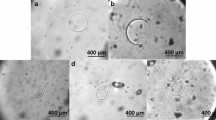Abstract
Ice recrystallization is a phenomenon in which large ice crystals are formed at the expense of smaller ones. The resultant large ice crystals degrade the quality of frozen foods and cryopreserved biomaterials. To minimize freeze damage by controlling the ice recrystallization process, various compounds have been developed, including biological antifreezes, synthetic peptides, glycopeptides, polymers, and small molecules. To compare their efficiency, evaluation methods of ice recrystallization inhibition are important. This chapter describes a practical protocol to quantify the inhibition efficiency by observing specific ice crystals exhibiting uniform growth.
Author contributions: A.R., Y.O., and S.T. designed research. A.R., H.K., Y.O., and S.T. performed research. A.R., S.T., and H.K. wrote the paper.
Access this chapter
Tax calculation will be finalised at checkout
Purchases are for personal use only
Similar content being viewed by others
References
Capicciotti CJ, Doshi M, Ben RN (2013) Ice recrystallization inhibitors: from biological antifreezes to small molecules. In: Recent developments in the study of recrystallization. INTECH Open, Ltd., London
Knight CA, Hallett J, DeVries AL (1988) Solute effects on ice recrystallization: an assessment technique. Cryobiology 25:55–60
Smallwood M, Worrall D, Byass L, Elias L, Ashford D, Doucet CJ, Holt C, Telford J, Lillford P, Bowles DJ (1999) Isolation and characterization of a novel antifreeze protein from carrot (Daucus carota). Biochem J 340:385–391
Tomczak MM, Marshall CB, Gilbert JA, Davies PL (2003) A facile method for determining ice recrystallization inhibition by antifreeze proteins. Biochem Biophys Res Commun 311:1041–1046
Knight CA, Wen D, Laursen RA (1994) Nonequilibrium Antifreeze Peptides and the Recrystallization of Ice. Cryobiology 32:23–34
Eniade A, Purushotham M, Ben RN, Wang JB, Horwath K (2003) A serendipitous discovery of antifreeze protein-specific activity in C-linked antifreeze glycoprotein analogs. Cell Biochem Biophys 38:115–124
Jackman J, Noestheden M, Moffat D, Pezacki JP, Findlay S, Ben RN (2007) Assessing antifreeze activity of AFGP8 using domain recognition software. Biochem Biophys Res Commun 354:340–344
Budke C, Heggemann C, Koch M, Sewald N, Koop T (2009) Ice recrystallization kinetics in the presence of synthetic antifreeze glycoprotein analogues using the framework of LSW theory. J Phys Chem B 113:2865–2873
Olijve LLC, Vrielink ASO, Voets IK (2016) A simple and quantitative method to evaluate ice recrystallization kinetics using the circle Hough transform algorithm. Cryst Growth Des 16:4190–4195
Hartel RW (1998) The properties of water in foods. Blackie Academic and Professional, London
Hartel RW (2001) Crystallization in foods. Aspen Publisher, Gaithersburg
Rahman AT, Arai T, Yamauchi A, Miura A, Kondo H, Ohyama Y, Tsuda S (2019) Ice recrystallization is strongly inhibited when antifreeze proteins bind to multiple ice planes. Sci Rep 9:2212
Mahatabuddin S, Hanada Y, Nishimiya Y, Kondo H, Tsuda S (2017) Concentration-dependent oligomerization of an alpha-helical antifreeze polypeptide makes it hyperactive. Sci Rep 7:42501
Nishimiya Y, Kondo H, Takamichi M, Sugimoto H, Suzuki M, Miura A, Tsuda S (2008) Crystal structure and mutational analysis of Ca2+-independent type II antifreeze protein from Longsnout poacher, Brachyopsis rostratus. J Mol Biol 382:734–746
Nishimiya Y, Sato R, Takamichi M, Miura A, Tsuda S (2005) Co-operative effect of the isoforms of type III antifreeze protein expressed in Notched-fin eelpout, Zoarces elongatus Kner. FEBS J 272:482–492
Mahatabuddin S, Fukami D, Arai T, Nishimiya Y, Shimiyu R, Shibayaki C, Kondo H, Adachi M, Tsuda S (2018) Polypentagonal ice-like water networks emerge solely in an activity-improved variant of ice-binding protein. Proc Natl Acad Sci USA 115:5456–5461
Cheng J, Hanada Y, Miura A, Tsuda S, Kondo H (2016) Hydrophobic ice-binding sites confer hyperactivity of an antifreeze protein from a snow mold fungus. Biochem J 473:4011–4026
Takamichi M, Nishimiya Y, Miura A, Tsuda S (2007) Effect of annealing time of an ice crystal on the activity of type III antifreeze protein. FEBS J 274:6469–6476
Rasband WS (1997–2018) ImageJ. U.S. National Institutes of Health, Bethesda. https://imagej.nih.gov/ij/
Acknowledgments
This work was supported by the Japan Society for the Promotion of Science (JSPS) KAKENHI grant numbers 19H02529 and 19K22989 (for S.T.).
Author information
Authors and Affiliations
Corresponding author
Editor information
Editors and Affiliations
Rights and permissions
Copyright information
© 2024 The Author(s), under exclusive license to Springer Science+Business Media, LLC, part of Springer Nature
About this protocol
Cite this protocol
Rahman, A.T., Ohyama, Y., Tsuda, S., Kondo, H. (2024). Evaluation of Ice Recrystallization Inhibition of Ice-Binding Proteins by Monitoring Specific Ice Crystals. In: Drori, R., Stevens, C. (eds) Ice Binding Proteins. Methods in Molecular Biology, vol 2730. Humana, New York, NY. https://doi.org/10.1007/978-1-0716-3503-2_6
Download citation
DOI: https://doi.org/10.1007/978-1-0716-3503-2_6
Published:
Publisher Name: Humana, New York, NY
Print ISBN: 978-1-0716-3502-5
Online ISBN: 978-1-0716-3503-2
eBook Packages: Springer Protocols




